Sierra Nature Notes, Volume 2, December 2002
Fire
Regimes
in Sierran Mixed-Conifer Forests
by Dr. Thomas W. Swetnam and Mr. Christopher H. Baisan
Laboratory of Tree-Ring
Research
The University of Arizona
Why is fire important in forest ecology?
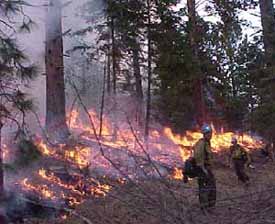 Forest
ecosystems throughout the world have evolved over millions of years with fire
as a common disturbance process. Fires caused by lightning have been an evolutionary
factor since plants first arrived on land. Lightning is still the most common
source of fire in many terrestrial ecosystems. Since the recent evolution
of humans and our acquisition of fire as a tool, we too have become a common
source of fire. Past human uses of fire for manipulating vegetation, however,
was highly variable from one place and time to another. In many remote mountain
areas, and before the 20th century, other biotic and physical features
of the landscape were probably more important than people in controlling fire
patterns. These factors include vegetation, topography, and climate. Many
species of plants in fire-prone habitats have evolved special adaptations
and survival strategies that help them persist and thrive with fire. In fact,
without fire, many of these species are unable to regenerate and compete effectively
within their community. Semi-arid forests, woodlands, grasslands and chaparral
are particularly well adapted to fire with species that are either resistant
to fire damage or are able to re-sprout from undamaged root systems or buried
seeds.
Forest
ecosystems throughout the world have evolved over millions of years with fire
as a common disturbance process. Fires caused by lightning have been an evolutionary
factor since plants first arrived on land. Lightning is still the most common
source of fire in many terrestrial ecosystems. Since the recent evolution
of humans and our acquisition of fire as a tool, we too have become a common
source of fire. Past human uses of fire for manipulating vegetation, however,
was highly variable from one place and time to another. In many remote mountain
areas, and before the 20th century, other biotic and physical features
of the landscape were probably more important than people in controlling fire
patterns. These factors include vegetation, topography, and climate. Many
species of plants in fire-prone habitats have evolved special adaptations
and survival strategies that help them persist and thrive with fire. In fact,
without fire, many of these species are unable to regenerate and compete effectively
within their community. Semi-arid forests, woodlands, grasslands and chaparral
are particularly well adapted to fire with species that are either resistant
to fire damage or are able to re-sprout from undamaged root systems or buried
seeds.
What can tree-ring studies tell us about the role of fire in forests?
Tree-rings
and fire scars
Many trees in temperate regions (those with a strong seasonal climate)
produce annual growth layers that appear as rings in a cross sectional view
of a tree stem. Variations in growing conditions from year-to-year produce
a sequence of wide, narrow, and average ring widths. Over time the sequence
forms a unique pattern that can be used like a fingerprint to determine the
calendar year in which each ring was produced. This procedure is called crossdating.
Events in a trees life that have a recognizable impact on its growth may also
be dated once the dates of the annual rings are known. Low to moderate intensity
fires that burned through a forest may injure or scar surviving trees, leaving
a clear record of their passage. Records of fires from many fire-scarred trees
can be compared to provide a history of the frequency, extent, and character
of this process through time. Since the events can be dated to the exact calendar
year, and in some cases to the season, records from one area can be compared
to records from any other, as well as with independent historical records
and reconstructions of past climate.
Fire in the
sequoia groves
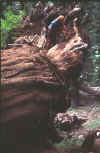 Sierra
sequoia mixed-conifer forests are a typical example of a fire-adapted forest
complex. The dominant tree species have elevated canopies and thick fire-resistant
bark. They can easily survive low-intensity surface fires that were common
in past centuries. Giant sequoias, for example, have bark up to half a meter
thick, great height (up to 90 meters), cones that open to drop their seeds
following heating by fires, and seedlings that require mineral soil and abundant
light to survive. These characteristics allow adults to survive all but the
most intense fires, and their seedlings to colonize areas cleared of forest
litter and potential competitors.
Sierra
sequoia mixed-conifer forests are a typical example of a fire-adapted forest
complex. The dominant tree species have elevated canopies and thick fire-resistant
bark. They can easily survive low-intensity surface fires that were common
in past centuries. Giant sequoias, for example, have bark up to half a meter
thick, great height (up to 90 meters), cones that open to drop their seeds
following heating by fires, and seedlings that require mineral soil and abundant
light to survive. These characteristics allow adults to survive all but the
most intense fires, and their seedlings to colonize areas cleared of forest
litter and potential competitors.
Sequoias are also excellent sources of information on the history of fires in their vicinity. Surface fires often scar trees around the base, wounding small areas of tissue that are subsequently grown over, enclosing the wound within the new wood. With individuals able to live more than 3,000 years the trees can contain many centuries of environmental history within their rot-resistant wood.
Wood sections cut from down sequoia logs and standing snags were used to reconstruct the fire history in five sequoia groves for the past 1,500 years. In two groves (the Giant Forest in Sequoia National Park and in Mountain Home State Forest) the data extends back more than 3,000 years. Due to the remarkable preservation of the wood a very detailed history was compiled with seasonal resolution and information on fire extent and severity for the groves.
Findings
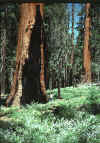 The
detailed fire histories reconstructed for the groves show that fire was a
frequent and pervasive influence in these forests for the entire length of
the record. Fires of some size occurred every few years with larger fires
occurring once or twice per decade. Regional fire years were also apparent
in the record, with four or five groves recording the same fire dates at a
greater frequency than would be expected by chance. Frequencies of these regional
events varied from 2 to 5 times per century. This variability in fire synchrony
and frequency through time appears to typify the record and suggests that
factors controlling fire regimes varied through time. Regional fire synchrony
indicates the importance of climate in landscape pre-conditioning and ignition
rates. Wet conditions probably inhibited fire ignition and spread while accelerating
fuel production and accumulation. Dry conditions favored effective ignition
and spread. Persistence of cool/moist conditions for extended periods seemed
to result in decreased fire frequency while increasing typical fire size and
intensity. This probably occurred because longer intervals between fires resulted
in more abundant and continuous fuels and, therefore, larger areas were burned
during dry/warm conditions that eventually arrived. Long-term warm/dry conditions
may have had the opposite effect, with more frequent fires, but less spatial
continuity of fuels and, consequently smaller fires.
The
detailed fire histories reconstructed for the groves show that fire was a
frequent and pervasive influence in these forests for the entire length of
the record. Fires of some size occurred every few years with larger fires
occurring once or twice per decade. Regional fire years were also apparent
in the record, with four or five groves recording the same fire dates at a
greater frequency than would be expected by chance. Frequencies of these regional
events varied from 2 to 5 times per century. This variability in fire synchrony
and frequency through time appears to typify the record and suggests that
factors controlling fire regimes varied through time. Regional fire synchrony
indicates the importance of climate in landscape pre-conditioning and ignition
rates. Wet conditions probably inhibited fire ignition and spread while accelerating
fuel production and accumulation. Dry conditions favored effective ignition
and spread. Persistence of cool/moist conditions for extended periods seemed
to result in decreased fire frequency while increasing typical fire size and
intensity. This probably occurred because longer intervals between fires resulted
in more abundant and continuous fuels and, therefore, larger areas were burned
during dry/warm conditions that eventually arrived. Long-term warm/dry conditions
may have had the opposite effect, with more frequent fires, but less spatial
continuity of fuels and, consequently smaller fires.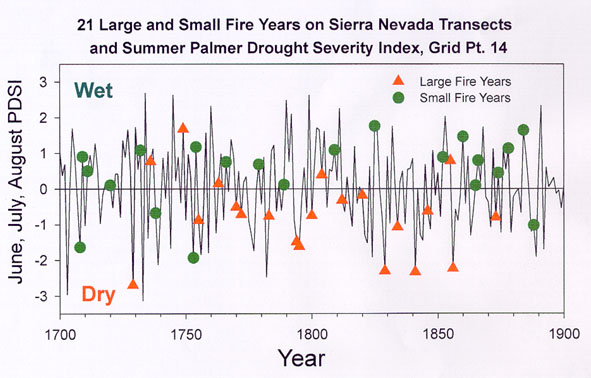
Observed temporal fluctuations in fire frequency and synchrony correspond
to independent estimates of past climate. A maximum in fire frequency occurred
from about AD 1000 to about AD 1300 during the Medieval Warm Period, bracketed
by minima in fire frequency and temperature. The latter relatively cool period
is known as the Little Ice Age. In addition to the century-scale patterns,
decadal fluctuations in fire frequency also match similar changes in summer
temperature reconstructions for the Sierra Nevada. At the year-to year or
seasonal time scale, winter-spring drought was the most important factor influencing
fire occurrence.
Fire in other
Sierrian forest types
Fires
were, and continue to be important within the entire range of forest types
in the Sierra. Before the late 1800s, lower elevation pine-oak forests and
woodlands were subject to relatively frequent (2-6 years), but low-intensity
fires. As elevation increases and forest conditions become cooler and wetter,
fire frequency decreased. For some areas along the west face of the Sierra,
fire-frequency varied systematically with elevation. However, fire in the
Yosemite area had a weak relationship with elevation; generally high fire
frequencies occurred throughout the studied area. This may be due to the complexity
of the terrain and its highly dissected nature. Another factor may have been
increased burning of this landscape by Native American populations.
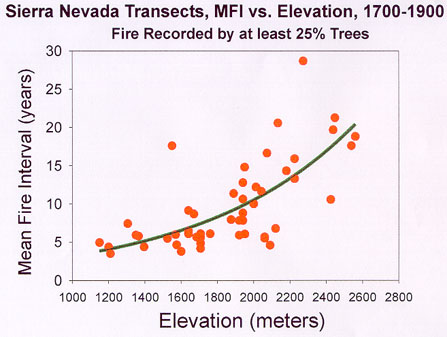
How have fire and climate interacted over the past several millennia?
The long sequoia record shows clearly that fire regimes were not constant through time but fluctuated as climate and forest conditions changed. Warm climatic episodes may result in higher fire frequencies, but fire-fuel feedbacks tend to result in smaller, patchier fires over time. Conversely, cooler wetter periods may decrease fire frequency, but may result in more extensive and severe fires as fuel accumulates between events. Furthermore, extreme events may be most likely during shifts of climatic state, such as in the warm-dry to cool-wet transition around the end of the thirteenth century. We have found evidence, for example, of widespread and unusually severe fires in some of the sequoia groves at this time.
What can we
expect in the future?
We
should expect fire regimes to continue evolving in tune with changes in forest
conditions and fluctuations in climate. Altered fire regimes in a warmer climate
(more frequent burning) could help push forest-type boundaries upslope and
change the reproductive success of forest tree species leading to changes
in species composition within types. Higher precipitation coupled with a warmer
climate could lead to increases in fuel production, with corresponding increases
in fire intensity and size. Warmer-drier conditions might initially lead to
intense fires followed by a decrease in fire severity as fuel production declined.
The paleofire reconstructions demonstrate that the forest-climate system is
highly dynamic. Although relatively stable states persisted for centuries,
large changes also occurred in the record. The past does not provide a perfect
analog for expected future changes, but it does tell us how these dynamic
systems responded to past climate changes. The past also helps us understand
how we arrived at the current state of conditions.
|
|
Dr.
Thomas W. Swetnam Mr.
Christopher H. Baisan |
This article first appeared at the USGS Western Ecological Research Center website. Permission to reprint on Nature Notes was generously given by Dr. Swetnam.
For
Further Reading:
Web
Links:
Swetnam, T. W., R. Touchan, C. H. Baisan, A. C. Caprio, P. M. Brown 1991 Giant
sequoia fire history in the Mariposa Grove, Yosemite National Park.
pages 249-255 In: Yosemite Centennial Symposium: Prospects for the Future,
October 13-20, 1990. National Parks Service, Denver Service Center,NPS D-374.
pdf file 99K
Caprio, Anthony C., and Thomas W. Swetnam
1995. Historic
fire regimes along an elevational gradient on the west slope of the Sierra
Nevada, California. In: J. K. Brown, R. W. Mutch, C. W. Spoon, and
R. H. Wakimoto, tech. coords., Proceedings: Symposium on Fire in Wilderness
and Park Management, Missoula, MT, March 30-April 1, 1993,. USDA Forest Service
General Technical Report INT-320:173-179. PDF File 386K
Swetnam, T. W. 2002. Fire
and climate history in the western Americas from tree rings. PAGES
News, 10(1) April 2002. pdf file 1,775K
Land
Use History of the Southwestern United States. These pages describe
my collaborative research with Dr. Craig Allen and Dr. Julio Betancourt of
the US Geological Survey. A hard copy version of this is in: Allen, Craig
D., Julio L. Betancourt, and Thomas W. Swetnam. 1998. Landscape changes in
the Southwestern United States: Techniques, Long-term Data Sets, and Trends.
Chapter 9, In Sisk, T.D., editor, Perspectives on the Land-Use History of
North America: A Context for Understanding Our Changing Environment. U.S.
Geological Survey, Biological Resources Division, Biological Science Report
USGS/BRD/BSR 1998-0003. 103 pp.
Climate
Change Impacts on Southwestern Ecosystems. These pages were part of
a web-based workshop on climate change assessments, and they describe my collaborative
research with Julio Betancourt. Most of this research is published in our
recent paper: Swetnam, T. W. and J. L. Betancourt. 1998. Mesoscale disturbance
and ecological response to decadal climatic variability in the American Southwest.
Journal of Climate 11:3128-3147.
Dieterich, J. and T.W. Swetnam. 1984. Dendrochronology of a fire-scarred ponderosa pine. For. Sci. 30:238-247.
Douglass, A.E. 1941. Crossdating in Dendrochronology. J. For. 39:825-831.
Fritts, H.C. 1976. Tree Rings and Climate. Academic Press, London. 567pp.
Fritts, H.C. 1991. Reconstructing Large-Scale Climatic Patterns from Tree-Ring Data. The University of Arizona Press, Tucson. 286 pp.
Fritts, H.C. and T.W. Swetnam. 1989. Dendrochronology: A tool for evaluating variations in past and present forest environments. Advances in Ecological Research. 19:111-188.
Stephenson, N.L., D.J. Parsons, and T.W. Swetnam 1989. Restoring natural fire to the sequoia-mixed conifer forest: should intense fire play a role? N. L. Proceedings 17th Tall Timbers Fire Ecology Conference. High Intensity Fire in Wildlands: Management Challenges and Options. May 18-21. Tallahassee, Florida. pp.321-337.
Stokes, M.A. and T.L. Smiley. 1968. An Introduction to Tree-Ring Dating. University of Chicago Press.
Swetnam, T.W. and J.L. Betancourt 1990. Fire-southern oscillation relations in the southwestern United States. Science 249:1017-1020.
Swetnam, T.W. 1993. Fire history and climate change in giant sequoia groves. Science. 262:885-889.
Van Pelt, N.S. and T.W. Swetnam. 1990. Conservation and stewardship of tree-ring resources: Living trees and sub-fossil wood. Natural Areas J. 10(1): 19-27
Our Founder Questions? Go to About Our New Site |
Masthead
Photo from: |